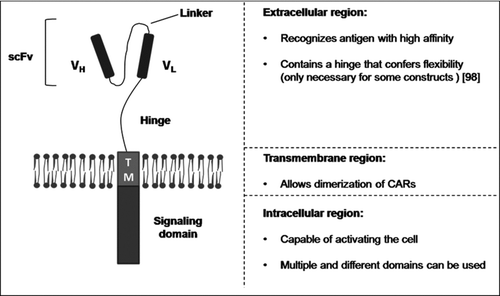Figures & data
FIGURE 1 Chimeric antigen receptor. Schematic representation of the standard structure of a chimeric antigen receptor. VH, heavy-chain variable domain; VL, light-chain variable domain; scFv, single chain fragment variable.

TABLE 1 Published clinical trials
FIGURE 2 Strategies to circumvent off-target effects. The off-target effects can be minimized through (a) a suicide gene system to delete remaining cells that recognize the target antigen; (b) splitting the activation endodomains (signal 1 and signal 2) in two different CARs to enable a complete activation response only after interaction of both CARs with their target antigens at the tumor surface. A similar approach was published by Duong et al. and consisted of using two different CARs to promote more potent responses against target cells expressing two tumor antigens [Citation89]; (c) the use of inhibitory CARs, besides an activating receptor, to impair T-cell activation after interaction with the target antigen at the normal tissues; (d) fine tuning of CAR affinity based on the target antigen level of expression. In an ideal situation, it is possible that a lower affinity would lead to recognition of tumor cells expressing high levels of antigen, sparing normal cells with low expression of the same antigen.
![FIGURE 2 Strategies to circumvent off-target effects. The off-target effects can be minimized through (a) a suicide gene system to delete remaining cells that recognize the target antigen; (b) splitting the activation endodomains (signal 1 and signal 2) in two different CARs to enable a complete activation response only after interaction of both CARs with their target antigens at the tumor surface. A similar approach was published by Duong et al. and consisted of using two different CARs to promote more potent responses against target cells expressing two tumor antigens [Citation89]; (c) the use of inhibitory CARs, besides an activating receptor, to impair T-cell activation after interaction with the target antigen at the normal tissues; (d) fine tuning of CAR affinity based on the target antigen level of expression. In an ideal situation, it is possible that a lower affinity would lead to recognition of tumor cells expressing high levels of antigen, sparing normal cells with low expression of the same antigen.](/cms/asset/a826426d-aad6-4bb4-b86c-7348297e9115/iiri_a_595855_f0002_b.gif)